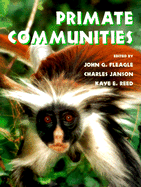Book contents
- Frontmatter
- Contents
- List of contributors
- Preface
- 1 African primate communities: Determinants of structure and threats to survival
- 2 Biomass and use of resources in south and south-east Asian primate communities
- 3 Species coexistence, distribution, and environmental determinants of neotropical primate richness: A community-level zoogeographic analysis
- 4 Primate communities: Madagascar
- 5 Primate diversity
- 6 Phylogenetic and temporal perspectives on primate ecology
- 7 Population density of primates in communities: Differences in community structure
- 8 Body mass, competition and the structure of primate communities
- 9 Convergence and divergence in primate social systems
- 10 Of mice and monkeys: Primates as predictors of mammal community richness
- 11 Comparing communities
- 12 Large-scale patterns of species richness and species range size in anthropoid primates
- 13 The recent evolutionary past of primate communities: Likely environmental impacts during the past three millennia
- 14 Resources and primate community structure
- 15 Effects of subsistence hunting and forest types on the structure of Amazonian primate communities
- 16 Spatial and temporal scales in primate community structure
- 17 Primate communities in Africa: The consequences of long-term evolution or the artifact of recent hunting?
- 18 The future of primate communities: A reflection of the present?
- 19 Concluding remarks
- Systematic index
- Subject index
3 - Species coexistence, distribution, and environmental determinants of neotropical primate richness: A community-level zoogeographic analysis
Published online by Cambridge University Press: 21 August 2009
- Frontmatter
- Contents
- List of contributors
- Preface
- 1 African primate communities: Determinants of structure and threats to survival
- 2 Biomass and use of resources in south and south-east Asian primate communities
- 3 Species coexistence, distribution, and environmental determinants of neotropical primate richness: A community-level zoogeographic analysis
- 4 Primate communities: Madagascar
- 5 Primate diversity
- 6 Phylogenetic and temporal perspectives on primate ecology
- 7 Population density of primates in communities: Differences in community structure
- 8 Body mass, competition and the structure of primate communities
- 9 Convergence and divergence in primate social systems
- 10 Of mice and monkeys: Primates as predictors of mammal community richness
- 11 Comparing communities
- 12 Large-scale patterns of species richness and species range size in anthropoid primates
- 13 The recent evolutionary past of primate communities: Likely environmental impacts during the past three millennia
- 14 Resources and primate community structure
- 15 Effects of subsistence hunting and forest types on the structure of Amazonian primate communities
- 16 Spatial and temporal scales in primate community structure
- 17 Primate communities in Africa: The consequences of long-term evolution or the artifact of recent hunting?
- 18 The future of primate communities: A reflection of the present?
- 19 Concluding remarks
- Systematic index
- Subject index
Summary
INTRODUCTION
Primates comprise the most intensively investigated mammalian order, with the vast majority of genera having been subjected to at least one single-species ecological study. It is thus paradoxical that primates still remain so poorly studied at the level of species assemblages, from the perspective of either synecological studies restricted to a single site (Terborgh, 1983; Peres, 1993a) or comparisons of multiple sites within or between continents (Bourlière, 1985; Waser, 1986; Peres, 1997a). As a consequence, many questions related to the determinants of local species richness and community assembly rules are yet to be addressed to primates (but see Cowlishaw & Hacker, 1997; Ganzhorn, 1997). This volume, therefore, goes some way towards a timely paradigm shift from the traditional emphasis on behavioral studies of primate groups and individuals to macroecological studies of populations and communities.
In this chapter we present a large-scale analysis of the structure of New World primate communities from the northern tropical forest frontier of southern Mexico to the subtropics of northern Argentina and southernmost Brazil (Appendix 3.1). Our primary goal is to examine the biogeographic determinants of species assemblages at a spatial scale covering the entire platyrrhine primate radiation. We investigate the effects of latitudinal gradients, forest types, extent of forest cover, and amount of rainfall on the central question in mainstream community ecology of how many species can coexist within a given area. Despite the nearly universal pattern of higher species diversity at lower latitudinal regions (Schall & Pianka, 1978; Brown & Gibson, 1983; Stevens, 1989; Pagel et al., 1991; Ruggerio, 1994; Eeley & Lawes, this volume), this relationship has been largely tested using widely distributed taxa occurring in both tropical and temperate habitats.
Information
- Type
- Chapter
- Information
- Primate Communities , pp. 55 - 74Publisher: Cambridge University PressPrint publication year: 1999
Accessibility standard: Unknown
- 56
- Cited by
